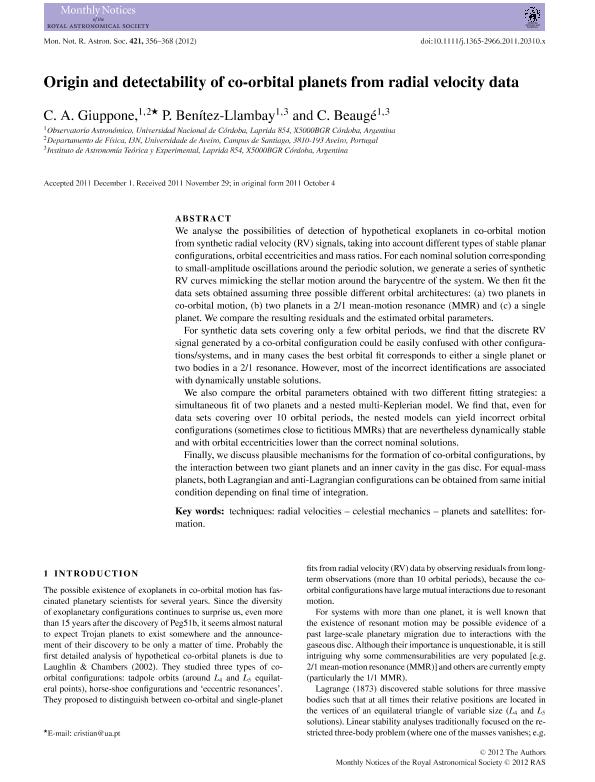Artículo
Origin and detectability of co-orbital planets from radial velocity data
Fecha de publicación:
03/2012
Editorial:
Wiley
Revista:
Monthly Notices of the Royal Astronomical Society
ISSN:
0035-8711
e-ISSN:
1365-2966
Idioma:
Inglés
Tipo de recurso:
Artículo publicado
Clasificación temática:
Resumen
We analyze the possibilities of detection of hypothetical exoplanets in coorbital motion from synthetic radial velocity (RV) signals, taking into account different types of stable planar configurations, orbital eccentricities and mass ratios. For each nominal solution corresponding to small-amplitude oscillations around the periodic solution, we generate a series of synthetic RV curves mimicking the stellar motion around the barycenter of the system. We then fit the data sets obtained assuming three possible different orbital architectures: (a) two planets in coorbital motion, (b) two planets in a 2/1 mean-motion resonance, and (c) a single planet. We compare the resulting residuals and the estimated orbital parameters. For synthetic data sets covering only a few orbital periods, we find that the discrete radial velocity signal generated by a coorbital configuration could be easily confused with other configurations/systems, and in many cases the best orbital fit corresponds to either a single planet or two bodies in a 2/1 resonance. However, most of the incorrect identifications are associated to dynamically unstable solutions. We also compare the orbital parameters obtained with two different fitting strategies: a simultaneous fit of two planets and a nested multi-Keplerian model. We find that, even for data sets covering over ten orbital periods, the nested models can yield incorrect orbital configurations (sometimes close to fictitious mean-motion resonances) that are nevertheless dynamically stable and with orbital eccentricities lower than the correct nominal solutions. Finally, we discuss plausible mechanisms for the formation of coorbital configurations, by the interaction between two giant planets and an inner cavity in the gas disk. For equal mass planets, both Lagrangian and anti-Lagrangian configurations can be obtained from same initial condition depending on final time of integration.
Archivos asociados
Licencia
Identificadores
Colecciones
Articulos(IATE)
Articulos de INST.DE ASTRONOMIA TEORICA Y EXPERIMENTAL
Articulos de INST.DE ASTRONOMIA TEORICA Y EXPERIMENTAL
Citación
Giuppone, Cristian Andrés; Benítez Llambay, Pablo; Beauge, Cristian; Origin and detectability of co-orbital planets from radial velocity data; Wiley; Monthly Notices of the Royal Astronomical Society; 421; 3-2012; 356-368
Compartir
Altmétricas




